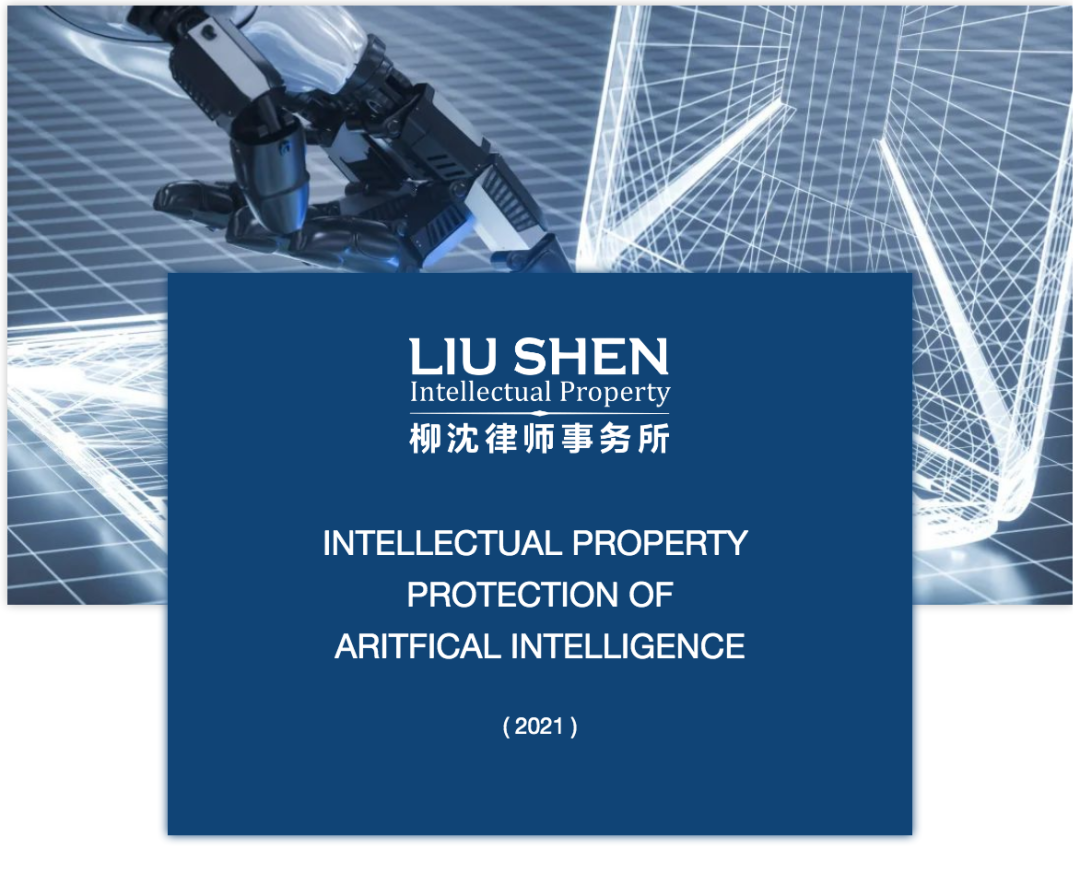
Click the topic to read previous chapters:
Chapter I: Overview of AI Technology
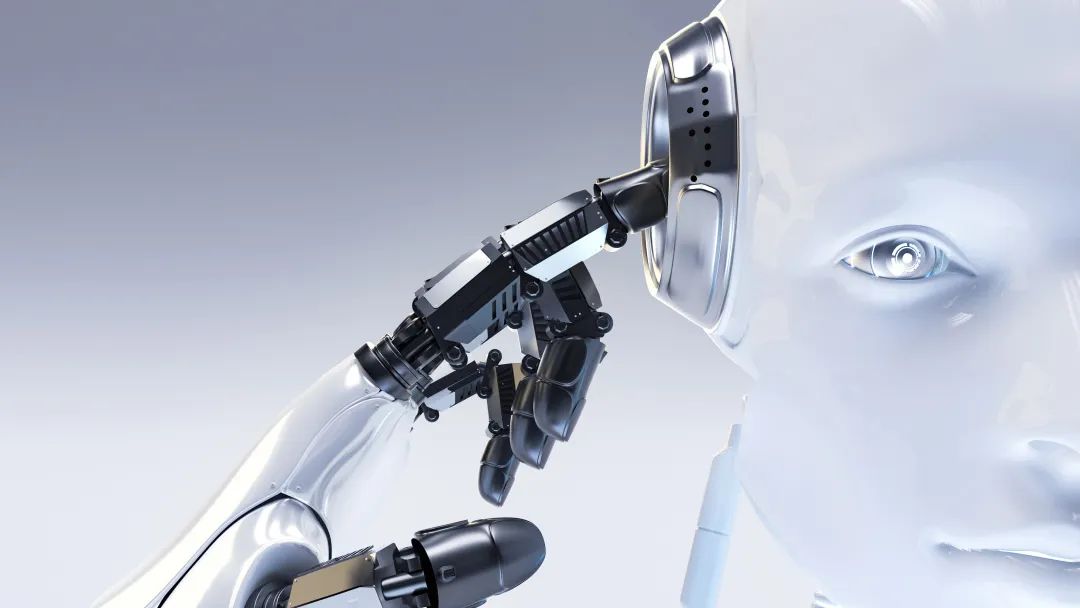
Chapter III
Patent Protection of AI in China and Other Major Jurisdictions
With the rapid development of Artificial Intelligence (AI) technology, a number of countries are constantly exploring the new challenges that the patent protection system brings to the patent protection system and the perfect demand for the protection system. In this chapter, the patent systems and practices of countries/regions where the five IP offices (CNIPA, USPTO, EPO, JPO, and KIPO) locate are taken as examples introduce AI patent protection in China and other major jurisdictions.
3.1 AI-related Patent Practice in China
3.1.1 Factors Considered in AI Patent Prosecution
Similar to normal patents, the drafting and prosecution of patents in the field of artificial intelligence need to take into account both the acquisition of patents and the exercise of patent rights after acquisition.
The main consideration for the acquisition of patent rights is to comply with the Patent Law, the Implementing Regulations of the Patent Law and the Guidelines for Patent Examination.
The main considerations for the exercise of patent rights include:
- Define broad scopes in the independent claims, and put additional technical features in the dependent claims to secure sub-scopes in an appropriate gradation;
- In order to avoid limiting application scenes of a technical solution, consider the whole industry chain, and draft multiple sets of claims to cover all valuable topics;
- Facilitate the identification of infringement;
- Improve the stability of patents to prevent invalidation.
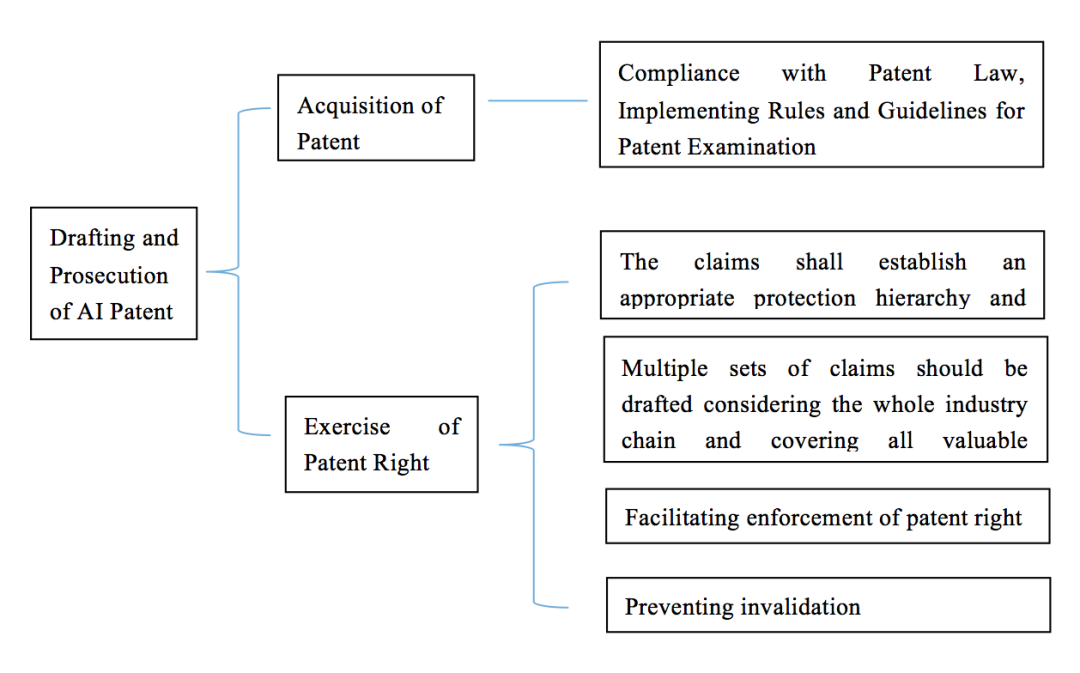 3.1.2 Main Legal Norms Related to Acquisition of Patent Rights
3.1.2 Main Legal Norms Related to Acquisition of Patent Rights
Main provisions involved in the acquisition of patent rights related to AI are the Patent Law, the Implementation Rules of the Patent Law and the Guidelines for Patent Examination, as shown in the table below.
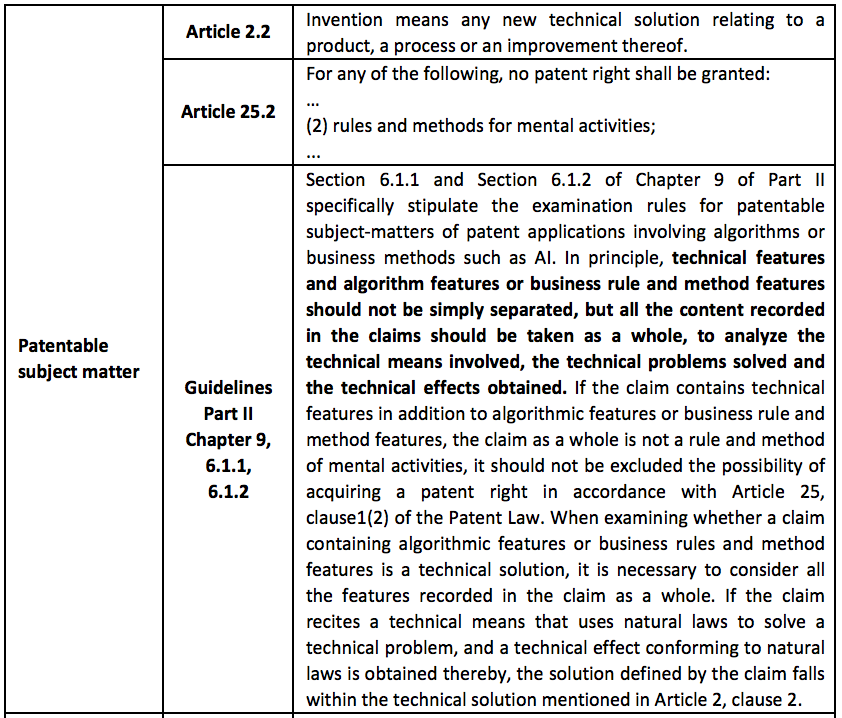
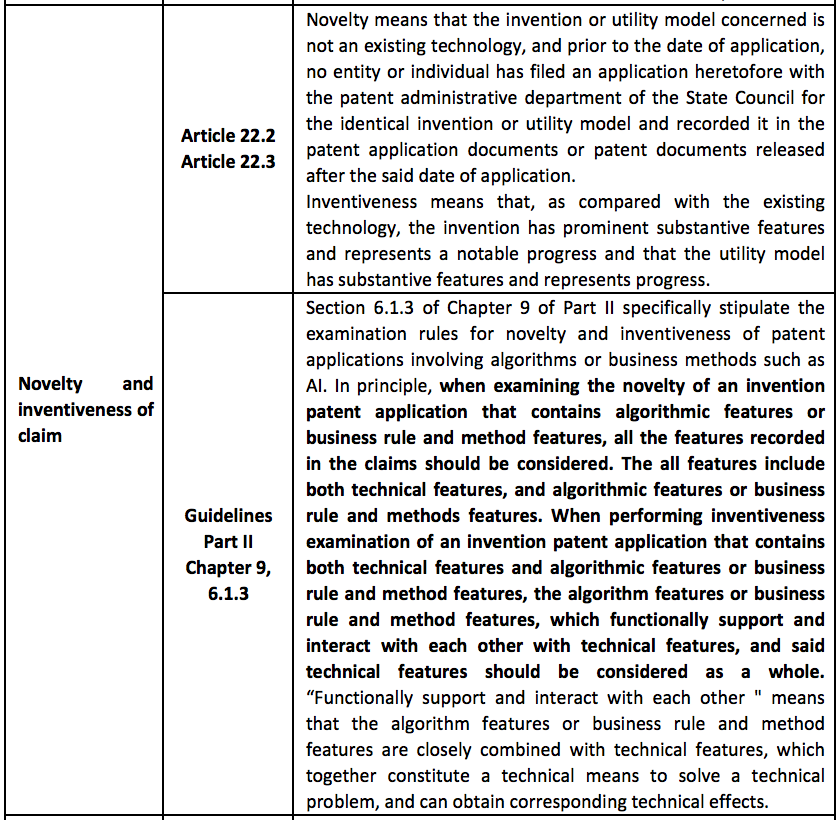
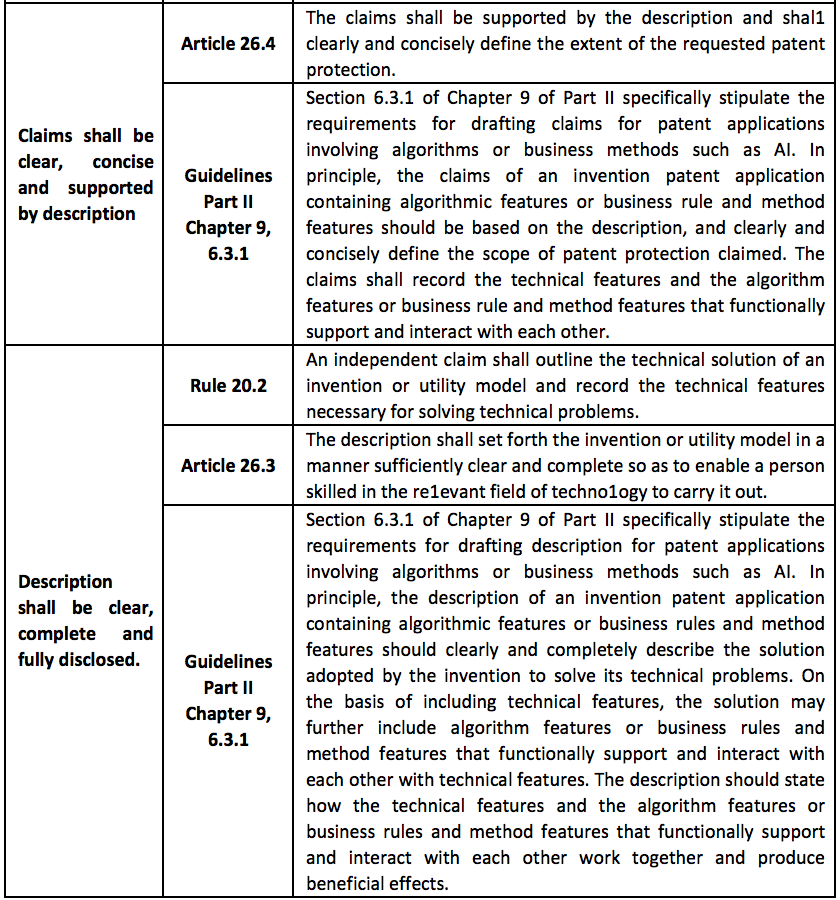
3.1.3 Eligibility Issue
3.1.3.1 The Provisions of the Guidelines for Patent Examination for the Eligibility Issue of AI-Related Inventions
In China, eligibility issue mainly involves two articles of the Patent Law, namely Article 2 and Article 25.
An “invention” is defined as a new technical solution relating to a product, a process or improvement thereof according to Article 2, clause 2 of the Patent Law. That is, any patentable application for invention in China must constitute a technical solution. To determine a technical solution, China adopts a “three-element criterion (i.e., technical problem, technical means and technical effect).” Under this criterion, a technical solution should aim for solving a technical problem, by using technical means in conformity with the laws of nature, and can produce technical effect in conformity with the laws of nature.
According to Article 25, clause 1(2) of the Patent Law of China, rules and methods for mental activities are not patentable since they generally do not solve any technical problems and therefore are not technical solutions. Therefore, pure algorithms or mathematical rules are excluded from patentability as being rules and methods for mental activities.
Section 6 of Chapter 9 of Part II of the Guidelines for Patent Examination provides specific provisions on the examination particularity of "invention patent applications containing algorithm features or business rules and method features". Such patent applications cover "AI", "Internet plus", "big data" and "blockchain". This section involves examination rules related to eligibility issue, novelty/inventiveness, and drafting requirements regarding claims and specifications. Specially, ten examples are incorporated to illustrate examination rules regarding the examination of eligibility issue and novelty/inventiveness. Brief introduction to the eligibility issue will be provided in the following.
According to the provisions of this part of the Guidelines for Patent Examination, applications related to new fields are first examined in accordance with Article 25 of the Patent Law. If the application passes the examination of Article 25, that is, the application is not a rule or method of mental activities, the examination is carried out in accordance with Article 2 of the Patent Law to check whether the application is a technical solution.
(1) Examination Rules for Article 25 of the Patent Law
For examination under Article 25, if a claim includes technical features in addition to features of rules or methods for mental activities, the claim as whole is not considered as a rule or method for mental activities, and thus cannot be ruled out from being patentable according to Article 25. On the contrary, if a claim does not include any technical features and includes only features of rules or methods for mental activities, then the claim is considered as a rule or method for mental activities and shall be ruled out according to Article 25.
[Example 1]
Example 1 illustrates a method for mental activities without any technical features. Example 1 is a method of establishing a mathematical model. The claim of this example is as follows.
A method for establishing a mathematical model, characterized by comprising the following steps of:
according to feature values of training samples of a first classification task and feature values of at least one of training samples of a second classification task, training an initial feature extraction model to obtain a target feature extraction model, wherein the second classification task is another classification task related to the first classification task;
according to the target feature extraction model, processing the feature values in respective training samples of the first classification task to obtain extracted feature values corresponding to respective training samples;
combining the extracted feature values and label values corresponding to respective training samples into extracted training samples, and training the initial classification model to obtain a target classification model; and
combining the target classification model and the target feature extraction model into a mathematical model of the first classification task.
The method comprises steps of processing feature values and training models. However, the method does not involve any specific application area. Accordingly, the feature values in the method are abstract mathematical data, the processing steps are abstract mathematical method steps, and the resulting model is an abstract general classification model. Therefore, the solution of example 1 does not involve any technical feature, and is thus a method for mental activities stipulated in Article 25.
(2) Examination Rules for Article 2 of the Patent Law
For Article 2, whether a claim is a technical solution is examined based on whether the claim as a whole uses a technical means conforming to natural laws to solve a technical problem and achieve a technical effect. In particular, if algorithm steps defined in a claim are related to a technical problem and achieves a technical effect, the claim is a technical solution in principle. For example, an algorithm step can be considered as being related to a technical problem if the algorithm step processes data with definite technical meaning in a specific technical field and the execution of the algorithm involves using natural laws to solve a technical problem.
Examples 2 to 6 are related to examination based on Article 2, where examples 2 to 4 are considered as technical solutions, and examples 5 and 6 are not considered as technical solutions.
[Example 2]
Example 2 is related to a training method for a convolutional neural network (CNN) model. The claim of this example is as follows.
A method for training a CNN model, characterized by comprising:
obtaining initial model parameters of the CNN model to be trained, wherein the initial model parameters include an initial convolution kernel of each level of convolutional layer, an initial bias matrix of each level of convolutional layer, an initial weight matrix of fully connected layer, and an initial bias vector of the fully connected layer;
obtaining multiple training images;
at each level of convolutional layer, , performing a convolution operation and a maximum pooling operation on each training image by using the initial convolution kernel and the initial bias matrix at each level of convolutional layer to obtain a first feature image of each training image at each level of convolutional layer;
performing a horizontal pooling operation on the first feature image of each training image at at least one level of convolutional layer to obtain a second feature image of each training image at each level of convolutional layer;
determining a feature vector of each training image according to the second feature image of each training image at each level of convolutional layer;
processing each feature vector according to the initial weight matrix and the initial bias vector to obtain a category probability vector of each training image;
calculating a category error according to the category probability vector of each training image and an initial category of each training image;
adjusting the model parameters of the CNN model to be trained based on the category error;
continuing the process of model parameter adjustment based on the adjusted model parameters and the multiple training images until the number of iterations reaches a preset number; and
taking the model parameters obtained when the number of iterations reaches the preset number as the model parameters of the trained CNN model.
In this method, convolution operation and maximum pooling operation are performed on training images at each convolution layer, and then the feature images obtained after the maximum pooling operation are further horizontally pooled, so that the trained CNN model can recognize images of any size when identifying an image category. In this example, the data processed in the steps of the training method are image data, reflecting that the training algorithm is related to a specific technical field of image information processing. The training method in this example solves a technical problem that a CNN model can only recognize images of a fixed size and achieves a technical effect of recognizing images of any size by a technical means of performing different processing and training on images in different convolutional layers. Therefore, example 2 is a technical solution stipulated in Article 2.
[Example 3]
Example 3 is related to a method of using rental bikes. The claim of this example is as follows.
A method for using rental bicycles, characterized by comprising the following steps of:
Step 1: A user sends a request to use a rental bicycle to a server through a terminal device;
Step 2: The server acquires the user's first location information and retrieves a second location information of rental bicycles within a certain distance corresponding to the first location information and status information of these rental bicycles. The second location information and the status information of the rental bicycles are sent to the terminal device, wherein the first location information and the second location information are acquired through GPS signals;
Step 3: The user finds a target rental bicycle that can be ridden according to the location information of the rental bicycles displayed on the terminal device;
Step 4: The user scans a QR code on the body of the target rental bicycle through the terminal device, and obtains permission to use the target rental bicycle after being authenticated by the server;
Step 5: The server pushes a parking instruction to the user according to the riding situation. If the user parks the bicycle in a designated area, a discounted tariff will be used for billing, otherwise a standard tariff will be used for billing; and
Step 6: The user makes selection according to the instructions. After the riding is completed, the user performs a lock operation to the rental bicycle, and the rental bicycle sends a riding completion signal to the server after detecting a locked state.
In this method, a user initiates a use request of a rental bike through a user terminal device to a server, the server provides location information and state information of rental bikes around the user to the user terminal device based on the location of the user terminal device, and the user can find an available rental bike based on the information displayed on the user terminal device. The method uses computer programs in the user terminal device and the server to control or lead the way a user uses rental bikes. Collecting, calculating and using location information and state information involved in the claim are technical means to solve a technical problem of easily and precisely finding a rental bike. Therefore, example 3 is a technical solution stipulated in Article 2.
[Example 4]
Example 4 is related to a communication method between blockchain nodes. The claim of this example is as follows.
A method for block chain node communication, wherein block chain nodes in a block chain network include business nodes, the business node stores a certificate sent by a certificate authority (CA) and is pre-configured with a CA trust list, and the method comprises:
a first blockchain node receiving a communication request sent by a second blockchain node, wherein the communication request carries a second certificate of the second blockchain node;
determining a CA identifier corresponding to the second certificate;
judging whether the determined CA identifier corresponding to the second certificate exists in the CA trust list;
if yes, establishing a communication connection with the second blockchain node; and
if not, not establishing a communication connection with the second blockchain node.
The communication method uses a CA certificate and a pre-configured CA trust list to improve the security of data stored in the blockchain. Using a certificate to enhance communication security is a technical means conforming to natural laws to solve a technical problem. Therefore, example 4 is a technical solution stipulated in Article 2.
[Example 5]
Example 5 is related to a consumption rebating method. The claim of this example is as follows.
A method for consumption rebate, characterized by comprising the following steps of:
when a user makes a purchase at a merchant, the merchant returning a certain cash coupon according to an amount of consumption, Specifically, the merchant uses a computer to calculate the user's consumption amount, and divides the user's consumption amount R into M intervals, where M is an integer, and the value from interval 1 to interval M is from small to large, and an amount F of the returned cash coupon is also divided into M values, and the M values are also arranged from small to large;
according to the calculated value of the computer, determining that when the user's current consumption amount is in interval 1, the rebate amount is the first value, when the user's current consumption amount is in interval 2, the rebate amount is the second value, and so on, and returning the rebate amount of the corresponding interval to the user.
The method uses a computer to execute a set of rebate rules based on consumption amount to provide consumers with coupons so as to increase the consumers’ consumption willingness. In this method, the rebate rule is an artificial rule, which is not conforming to natural laws. Therefore, although the method is executed by a computer, the computer does not run a program conforming to natural laws. Therefore, example 5 is not a technical solution stipulated in Article 2.
[Example 6]
Example 6 is related to an analysis method for economic prosperity indexes based on characteristics of electricity consumption. The claim of this example is as follows.
A method for economic prosperity index analysis based on electricity consumption characteristics of a district, characterized by comprising the following steps of:
according to economic data and electricity consumption data of the district to be inspected, selecting preliminary indicators of the economic prosperity index of the district to be inspected, wherein the preliminary indicators include economic indicators and electricity consumption indicators;
determining an economic prosperity indicator system including leading indicators, consistent indicators and lagging indicators of the district to be inspected by executing a cluster analysis method and a time difference correlation analysis method with a computer; and
according to the economic prosperity index system of the district to be inspected, obtaining the economic prosperity index of the district to be inspected with a synthetic index calculation method.
The method evaluates economic prosperity indexes of districts based on electricity consumption characteristics of the districts by executing analysis algorithm on a computer. This example uses tools conforming to economical laws rather than natural laws; therefore it is not a technical solution stipulated in Article 2.
The above are the current provisions of the Guidelines for Patent Examination on AI-related object issues. In August 2021, in order to adapt to the implementation of the new Patent Law, CNIPA issued an amendment draft of the Guidelines for Patent Examination for the public to provide comments. In the draft, there is no change in principle of the content of part II, Chapter 9, Section 6, but a few specific operational rules and a few examples are added for the examination of eligibility and novelty/inventiveness. Specifically, for examination of the eligibility issue, it was added that "If the solution of a claim involves improvements of AI and big data algorithm, such as deep learning, classification, etc., and there is a specific technical association between the algorithm and the internal structure of the computer, which can solve technical problems of how to improve operating efficiencies or execution effects of the hardware, including reducing data storage amount, reducing data transmission amount, increasing hardware processing speed, etc., so as to obtain technical effects of internal performance improvements of computer systems conforming to the natural laws, then the solution defined by the claim belongs to the technical solution described in the Article 2, clause 2 of the Patent Law." and "If a claimed solution deals with big data in a specific application field, uses classification and clustering, regression analysis, neural network, etc. to mine the internal relationships conforming to the natural laws in the data, so as to solve technical problems of how to improve the reliability or accuracy of big data analysis in the specific application field, and obtain corresponding technical effects, then the solution defined by the claim belongs to the technical solution described in the Article 2, clause 2 of the Patent Law.” The draft provides clearer and more practical guidance on the eligibility issue of AI-related inventions.
3.1.3.2 Eligibility Issues Involved at Each Layer of AI Technology
As mentioned in the above, technical fields of AI can be roughly divided into three layers: application layer, enabling technology layer and infrastructure layer. This section will mainly discuss the eligibility issues that may occur at each technical level. According to the introduction of examination principles and rules of the eligibility issues mentioned above, the technologies that may have eligibility issues in AI technology mainly involve "data" and "algorithms" in the infrastructure layer and "business methods" in the solution layer of the application layer.
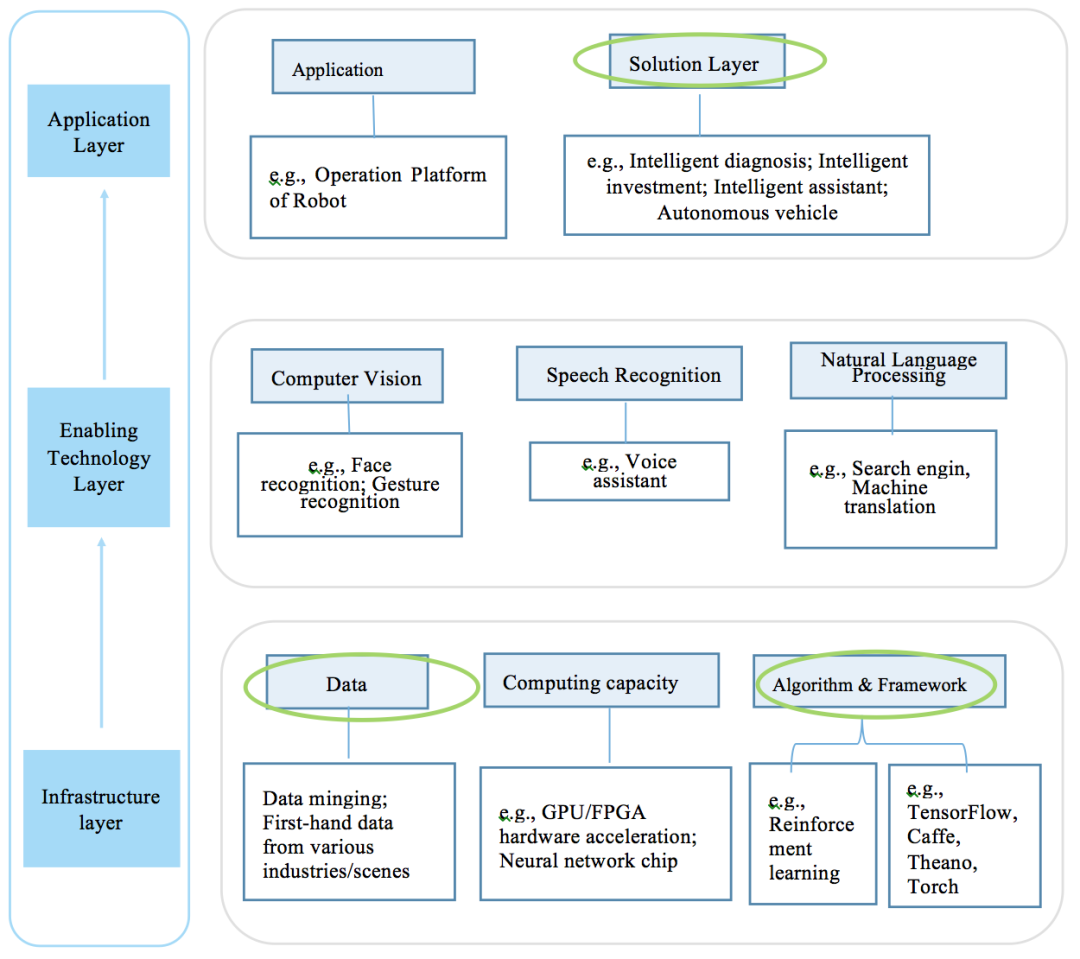
Fig. 3.1.3-1
3.1.3.2.1 Eligibility Issue of Patent Application Involving “Data” in AI Field
- Subject:
To determine if a claim involving big data and database relates to a method of information representation only.
- Criteria:
1. Without any technical features
If there isn’t any technical feature and the defined content is merely a human-defined data entry expression form, human-defined arrangement or definition of data fields, then it is actually a method of information representation, and the essence of claim protection is a set of specific data, which belongs to rules and method of mental activities and is not eligible;
2. Contains any technical features
If technical features are included in a subject matter, even if the title of subject matter is related to data or database, since the defined content is not merely a human-defined data entry expression form or a human-defined arrangement or definition of data fields, the subject matter is not a method of information representation, and thus does not belong to rules and methods of mental activities.
- Recommendations regarding drafting:
If, although a data architecture is involved, certain data processing is realized through such data architecture, and the overall solution adopts technical means such as storage and indexing to solve the technical problems of reducing redundancy and reducing the storage space requirement, and brings about corresponding technical effects, then it constitutes a technical solution and belongs to a patentable subject matter. Patent documents should be drafted in a manner that not only the features of the data itself are described, but technical features of specific processing of the data are reflected.
- Exemplary claims with eligibility issue for patent application involving "data" in AI field:
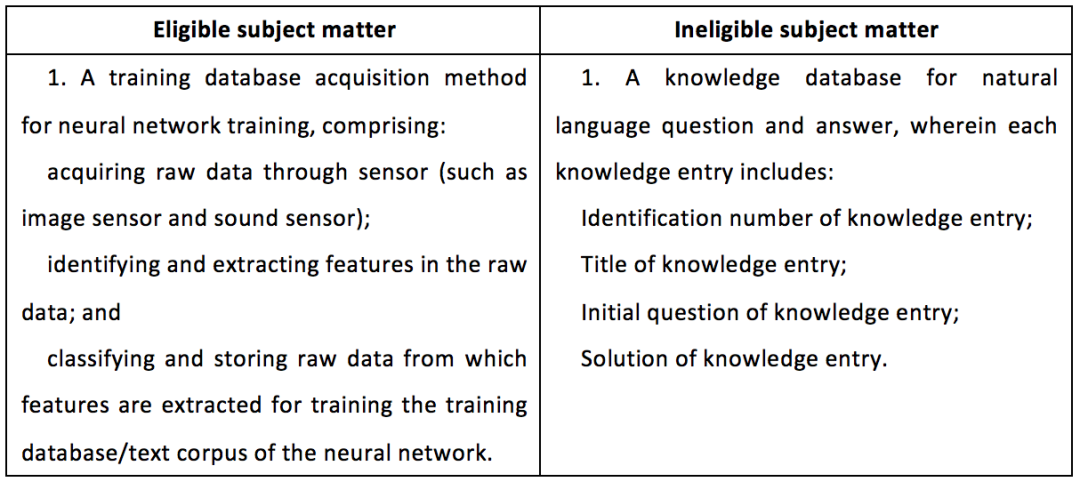
3.1.3.2.2 Eligibility Issue for Patent Application Involving "Algorithm" in AI Field
- Subject:
To determine if the claim involving algorithm is only algorithm or data computing rule or program itself.
- Criteria:
1. Pure algorithm or computing rule
Since pure algorithm or computing rule only relates to the use of computer programs for numerical operations, it belongs to rules and methods of mental activities, thus cannot be granted a patent right.
2. Combination of algorithm and general computer
If the combination can reflect improvement on internal performance of the computer system, the combination shall be a patentable subject matter.
Operations of performing an algorithm on a general computer are usually not deemed as a pure rule and method of mental activities since the claims include a general computer that performs mathematical operations. However, such a solution may still be deemed not to be a technical solution because it does not use technical means to solve the technical problems, and does not comply with Article 2, clause 2 of the Patent Law. Therefore, in the scheme of combining algorithms with general-purpose computers, it is necessary to further consider whether it solves technical problems and bring technical effects. If the improvement of the algorithm brings about the improvement of the computer performance, it shows that the technical problems are solved and the technical effects are brought, so the combination is a patentable subject.
3. Combination of algorithm and specific technical field
In the case of combination of algorithm and an applied technical field, parameters involved in the algorithm reflect the physical meaning of such a technical field, and the solution as a whole is no longer pure numerical operation but to solve technical problem in the specific application field. Therefore, the solution does not belong to the rules and methods of mental activities, but a technical solution.
- Suggestions on Drafting:
1. Establish clear technical correlation between each specific step of AI algorithm and the problem to be solved;
2. Relate factors in computation and data of AI algorithm to corresponding physical technical concepts;
3. Try to describe the relevant data processing in combination with computer process technology so as to distinguish the data processing from the abstract mathematic operation more clearly;
4. Emphasize that the technical solution as a whole has the three technical elements, and that technical problems in a specific technical field can be solved by applying the AI algorithm to address data processing in such field.
- Exemplary claims with eligible issue for patent application involving "algorithm" in AI field:
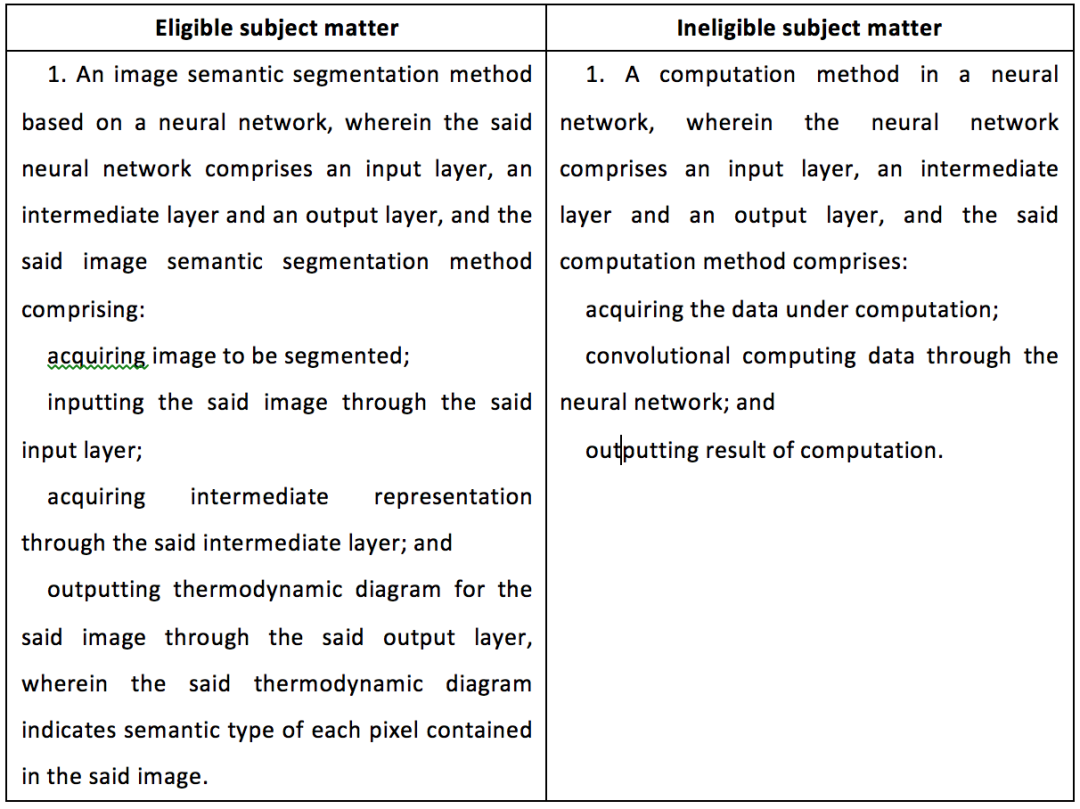
3.1.3.2.3 Eligibility Issue for Patent Application Involving "Business Method" in AI Field
- Subject:
Whether a claim relating to business methods involves a technical feature and solves a technical problem.
- Criteria:
Claims involving business methods are patentable if they contain both technical features and the content of business rules and methods, and solve technical problems by adopting natural laws.
- Suggestions on Drafting:
1. For a business method involving AI assistance, the combination of rule and technology should be reflected in the claim.
2. For a business method involving AI assistance, the solution shall reflect laws of nature.
- Exemplary claims with eligible issue for patent application involving " business method " in AI field:
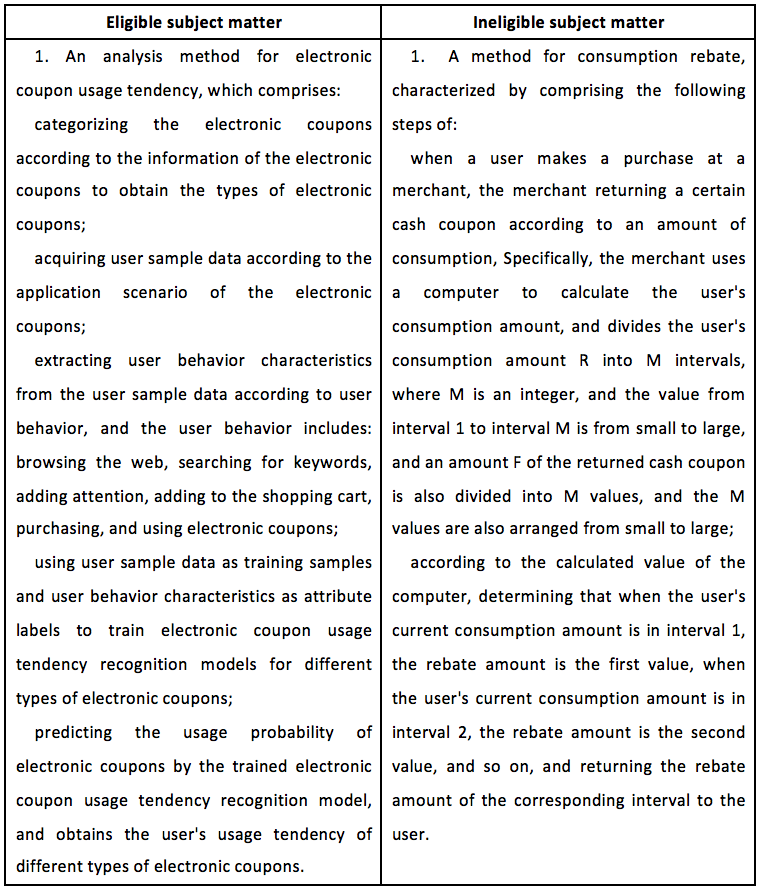
3.1.4 Novelty/Inventiveness
As mentioned above, Section 6 of Chapter 9 of Part II of the Guidelines for Patent Examination provides specific provisions on the examination particularity of "invention patent applications containing algorithm features or business rules and method features". This section introduces the related content of novelty and inventiveness.
As a basic principle, all the features (including technical features, algorithm features or business rules and method features) recorded in the claims should be considered as a whole during the examination and should not be simply separated. This principle prohibits the examiner from simply ignoring algorithm features or business rules and method features (such as algorithms and business rules), which are likely to be invention points in related new fields.
When examining novelty, all the features defined in the claims should be considered, including technical features and algorithm features or business rules and method features.
For inventiveness examination, algorithm features or business rules or methods and technical features that support each other functionally and have an interactive relationship with each other shall be considered as a whole. In other words, examiners cannot disregard features of algorithm or business rules or methods directly for inventive examination, but need to consider whether the features of algorithm or business rules or methods support technical features functionally and have an interactive relationship with technical features to determine whether the features of algorithm or business rules or methods have technical contributions to the prior art. If the features of algorithm or business rules or methods have technical contributions to the prior art, the features of algorithm or business rules or methods shall be considered to have contributions regarding the inventiveness examination; otherwise, they shall not be considered to have contributions to inventive examination. "The features of algorithm or business rules or methods and the technical features support each other functionally and have an interactive relationship with each other" means that the features of algorithm or business rules or methods are closely combined with the technical features to form a technical means to solve a technical problem and obtain a corresponding technical effect.
Here are four examples of the Guidelines for Patent Examination for inventiveness examination. In Example 1 and Example 2, the distinguishing feature relative to the closest prior art is the algorithm feature, but these algorithm features and related technical features are functionally mutually supportive and have an interactive relationship. Therefore, these algorithm features and technology features are considered together to evaluate inventiveness. In Example 3, the distinguishing feature relative to the closest prior art includes technical features and business rule features, which are functionally support each other and have an interactive relationship with each other. Therefore, these technical features and business rule features are considered together to evaluate inventiveness. In Example 4, the distinguishing feature relative to the closest prior art is the rule feature of mental activities, which does not support the technical features in function, nor does it have an interactive relationship with the technical features. Therefore, the characteristics of the mental activities rules are not considered to have a technical contribution to the prior art.
[Example 1]
Example 1 is related to a method for detecting a fall state of a humanoid robot based on multi-sensor information. The claim of this example is as follows.
A method for detecting a fall state of a humanoid robot based on multi-sensor information, characterized by comprising the following steps of:
(1) establishing a sensor information fusion model with a hierarchical structure by fusion of attitude sensor information, zero-moment point (ZMP) sensor information and robot walking stage information;
(2) determining the stability of the robot in the front and rear directions and the left and right directions by using a front-rear fuzzy decision-making system and a left-right fuzzy decision-making system, the specific steps are as follows:
① determining the walking stage of the robot according to the contact between the supporting feet of the robot and the ground and the offline gait planning;
② using fuzzy inference algorithm to fuzzify the position information of ZMP points;
③ using fuzzy inference algorithm to fuzzify the pitch angle or roll angle of the robot;
④ determining the output membership function;
⑤ determining fuzzy inference rules according to step ① to step ④;
⑥ defuzzifying.
The distinctive features with respect to the closest prior art are a specific fuzzy algorithm. The specific fuzzy algorithm takes the posture information, ZMP point position information and walking stage information as input parameters to calculate the information for determining the stable states of the humanoid robot, which provides a basis for further issuing accurate posture adjustment instructions. Therefore, the above algorithm features and other technical features such as determining the stable states of the humanoid robot defined in the claim are closely combined together to form a technical means, that is, they support each other functionally and interact with each other, and shall be considered together to evaluate inventiveness. Since no prior art discloses or teaches using the above fuzzy algorithm to determine the stable states of a humanoid robot, the solution of example 1 is considered to have inventiveness.
[Example 2]
Example 2 is related to a multi-robot path planning system based on a cooperative coevolution and multiple population genetic algorithm. The claim of this example is as follows.
A multi-robot path planning system based on a cooperative coevolution and multiple population genetic algorithm, which is characterized in that:
(1) A path of a robot is represented by a chromosome, and the chromosome is represented as a linked list of nodes, namely [(x, y), time], (x, y, timeR), (x, y) represents the robot’s position coordinates, time represents the time consumption of moving from this node to the previous node. The time of the start node is equal to 0. For the chromosome of each individual robot, the intermediate nodes and the number of nodes are variable except that the initial position of the initial node and the target position of the end node are fixed;
(2) The fitness function of path path(j) of each robot Robot(i) is expressed as φ (pi, j):
||pi, j||=Distance (pi, j) + ws × smooth (pi, j)+ wt × Time(pi, j)
Where ||pi, j|| is a linear combination of distance, smoothness and time consumption, ws is a smoothing weighting factor, wt is a time weighting factor; Distance (pi, j) represents the path length, and smooth (pi, j) represents the smoothness of the path, Time(pi,j) is the time consumption of path pi,j; each robot uses the fitness function to obtain the optimal path through Messy genetic algorithm optimization.
The distinctive features with respect to the closest prior art are a Messy genetic algorithm for multi-robot path planning. The forward paths of the robots are obtained with optimization of the Messy genetic algorithm. Therefore, the above algorithm features and other technical features such as paths and locations of the robots defined in the claim support each other functionally and interact with each other, and shall be considered together to evaluate inventiveness. However, in example 2, another prior document discloses using various genetic algorithms to optimize paths, and Messy genetic algorithm can obtain better optimization results. Therefore, the solution of example 2 is considered to lack inventiveness in view of the combination of the two prior art documents.
[Example 3]
Example 3 is related to a logistics distribution method. The claim of this example is as follows.
A logistics distribution method, which improves the efficiency of logistics distribution by notifying users in batches for pickup, wherein the method comprises:
when a deliverer needs to notify users to pick up goods, the deliverer sends a notification that the goods have arrived to the server through a handheld logistics terminal;
the server notifies in batches all order users within the delivery range of the deliverer;
order users who have received the notification perform the pickup according to the notification information;
wherein, the specific implementation method of the server to notice in batches is that the server determines all target order information within the delivery distance corresponding to the deliverer ID and centered on the current location of the logistics terminal, according to the deliverer ID carried in the arrival notification sent by the logistics terminal, the current location of the logistics terminal, and the corresponding delivery range, and then pushes the notification information to order user terminals corresponding to all the order user accounts in the target order information.
The distinctive features with respect to the closest prior art are notifying all ordering users within a delivery range in batch rather than notifying them one by one and accordingly different specific notification implementations such as different data architectures and communication methods. The feature of notification rule and the features of specific notification implementations support each other functionally and interact with each other, and shall be considered together. Since no prior art discloses or teaches using the above features to improve delivery efficiency, the solution of example 3 is considered to have inventiveness.
[Example 4]
Example 4 is related to a visualization method for dynamic viewpoint evolution. The claim of this example is as follows.
A visualization method for dynamic viewpoint evolution, which comprises:
Step 1: A computing device determines emotional membership degree and emotional classification of information in a collected information set, wherein the emotional membership degree of the information indicates how likely the information belongs to a certain emotional classification;
Step 2: The emotion is classified as positive, neutral or negative. The specific classification method is: if the value r of the number of likes p divided by the number of unlikes q is greater than a threshold a, then the emotion classification is considered to be positive, if the value r is less than a threshold b, then the emotion classification is considered as negative, if the value b≤r≤a, then the emotion classification is neutral, where a>b;
Step 3: Based on the emotion classification of the information, a geometric layout of an emotion visualization graph of the information set is automatically established, and the horizontal axis represents the time when the information is generated, and the vertical axis represents the amount of information belonging to each emotion classification;
Step 4: The computing device colors the established geometric layout based on the emotional membership degree of the information, and colors the information on each emotion classification layer according to the gradual order of the color of the information.
The method automatically collects information on an event published by people on social platforms, analyzes the emotions in the information, and visualizes changes of the emotions over time by coloring diagrams to be displayed in a computer. The closest prior art discloses a similar method, and the difference is only that the solution of example 4 uses a different emotion classification rule to determine the emotions and their changes. The emotion classification rule is an artificial rule, and the rule does not influence the coloring process. In other words, the feature of emotion classification rule and the technical feature of coloring process do not support each other functionally and do not interact with each other. Therefore, the distinctive feature is considered as an isolated feature of rules for mental activities, and even if no prior art document discloses such a feature, the solution of example 4 is considered to lack inventiveness since it has no technical contributions to the prior art.
3.1.5 Drafting of Claims
3.1.5.1 Considerations of Compliance with Requirements for Granting
- Requirement for Subject Matter Title
According to the current Examination Guidelines, the claims of an invention application relating to computer programs may be drafted as process (method) claim or product claim, i.e., the apparatus for executing the process. An ambiguous subject matter of a claim such as “a technique for...” or “an algorithm for...” should be not allowable since it is not clear whether it is claimed for the protection of a product or a method.
Even though there is no definition to what a product is, it is generally understood that a patentable “product” in China should be a physically tangible product, rather than an intangible object such as a program model. Therefore, a claim which directly claims for the protection of algorithms or mathematical models is not patentable in China. According to the current Guidelines for Patent Examination, software-related patent claims can generally be written as "methods", "devices" and "computer-readable storage media". However, according to the draft of the Guidelines for Patent Examination published in August 2021, "computer program product" will also become an acceptable form of claim, for example, "a computer program product including a computer program/instruction, when executed by a processor, performs the following steps:..."
Further, for an AI related invention, it is highly recommended to specify the technical field or application scenario utilizing the AI in the subject matter portion of and independent claim so that the claim may constitute a technical solution to be allowed in China.
For example, assuming a prediction model or learning model is applied to the technical field of autonomous vehicle for the purpose of predicting the behavior or action to be taken by the vehicle, an independent claim of the invention may be drafted as a product claim, e.g., “a driverless vehicle comprising a processor and a memory storing computer executable instructions which, when executed by the processor, cause the processor to perform operations including… (specific operations of the prediction model)”, and/or a method claim, e.g., “a method of predicting behavior of a driverless vehicle, the method comprising… (specific operations of the prediction model)”.
- Technical Solution Requirement
First of all, according to the above description of the eligibility issue, the solution protected by the claims should be a technical solution, which must meet the requirements of the Patent Law and the Guidelines for Patent Examination for the protected object.
In addition, the following issues should be paid attention to in practice when drafting the technical solutions of AI-related claims.
(1) No matter what kind of claim format is drafted, the claim shall reflect the technical solution of the invention in its entirety and record the essential technical features for resolving the technical problems, but cannot only generalize the functions of the computer program and the effects the functions can achieve. If a method claim is drafted, the various functions performed by the computer program and the way to perform the functions shall be described in detail according to the steps of the process. If a product (e.g., an apparatus, a device) claim is drafted, a detailed account shall be given on the performing steps of the various functional component parts of the computer program.
(2) For an AI related invention, it is commonly seen that a claim comprises both technical features and non-technical features, e.g., algorithms or mathematical models. Under the current Examination Guidelines, the claim comprising both technical features and non-technical features shall not be excluded from patentability merely because of the non-technical features. However, if the non-technical features do not have contribution to the solving of a technical problem, it may be left out of consideration when determining the novelty/inventiveness of the technical solution claimed to be protected by the claim. Therefore, it is very important the non-technical features are drafted as being closely inter-connected with the technical features so as to function commonly with the technical features to resolve a technical problem.
- Inventiveness Requirements
China adopts a three-step method to determine the inventiveness of the solution defined by the claims, including: step 1, determining the closest prior art; step 2, determining the distinguishing features of the invention and the technical problem actually solved by the invention; step 3, determining whether the claimed invention is obvious to those skilled in the art.
According to the current Examination Guidelines, for AI-related inventions, when an invention patent application that contains both technical features and algorithmic features or business rule and method features is to be examined for inventiveness, the algorithm features or business rules or methods and technical features that support each other functionally and have an interactive relationship with each other shall be considered as a whole. "Functionally support each other and have an interactive relationship" means that the algorithm features or business rules and method features are closely combined with technical features, which together constitute a technical means to solve a technical problem, and can obtain corresponding technical effects. For example, if the algorithm in the claims is applied to a specific technical field and can solve a specific technical problem, then it can be considered that the algorithm feature and the technical feature support each other in function and interact with each other, and the algorithm feature becomes a part of the technical means adopted. In the inventiveness examination, the contribution of the described algorithm features to the technical solution shall be taken into consideration. For another example, if the implementation of the business rules and method features in the claims requires adjustment or improvement of technical means, then it can be considered that the business rules and method features and the technical features are functionally mutually supportive and interact with each other, and when inventiveness examination is being carried out, the contribution of the stated business rules and method features to the technical solution should be considered. Therefore, it is very important to describe in the claims how non-technical features interact with technical features in specific application scenarios, so as to jointly contribute to solving technical problems.
- Requirement for Support by the Description
According to Article 26, clause 4 of the Patent Law of China, “The claims shall be supported by the description and shall define the extent of the patent protection sought for in a clear and concise manner.”
In order to obtain relatively broader protection scope, it is common that a technical solution defined by a claim, especially an independent claim, is the summarization of the embodiments disclosed in the specification. Such summarization, however, is often objected by the examiner in an office action on the grounds that the protection scope of the claim is not supported by the specification. In such circumstances, the applicant’s arguments are difficult to be accepted by the examiner if no sufficient number of embodiments are recorded in the specification. As a result, the claim often needs to be specifically limited to be consistent with the disclosure of the specification.
For an AI related invention, e.g., if only an algorithm is disclosed in the specification for solving a technical problem, it is generally not allowable to summarize a generic term, such as “an algorithm” in an independent claim. Rather, the specific parameters of the algorithm in the application scenario may need to be recorded into the independent claim.
- Requirement for Clearness of Protection Scope
According to Article 26, clause 4 of the Patent Law of China, “The claims shall be supported by the description and shall define the extent of the patent protection sought for in a clear and concise manner.”
A claim should be defined with features that are defined clearly and concisely so that the claim may be construed as having definite protection scope. Therefore, long and ambiguous sentences in a claim should be avoided as far as possible.
3.1.5.2 Considerations of Sufficient Protection
- Proper Hierarchy of Claims Drafting
It is preferable to draft a larger scope of protection in independent claims, and further restrict additional technical features to form a smaller scope of protection in dependent claims, so as to establish a reasonable hierarchy and level of protection. The purpose of establishing a reasonable hierarchy and level of protection is to make the scope of patent protection expandable, for example, drafting dependent claims to include additional non-technical problems that are solved on the basis of the solution of the technical problems, additional non-technical means on the basis of the technical means, and additional non-technical effects that are achieved on the basis of the achievement of the technical effects, could be helpful, so as to provide a multi-level flexible defense system in both prosecution and invalidation procedure, as shown below.
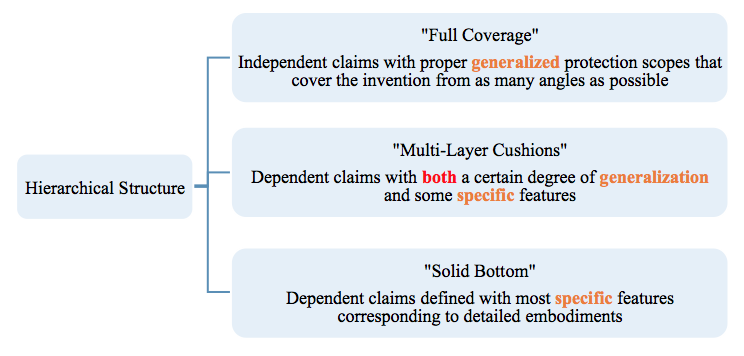
- Subjects Covered by the Claims
In order to facilitate the enforcement of patent rights, the entire industry chain should be considered, multiple sets of claims should be drafted to cover all valuable subjects, claiming at the same time methods, devices, storage media and systems.
The following are some examples of drafting:
1. An image semantic segmentation method based on a neural network, wherein the neural network comprises an input layer, an intermediate layer and an output layer, and the said image semantic segmentation method comprises: . . .
2. A training method for neural network for image semantic segmentation, wherein the said neural network comprises an input layer, an intermediate layer and an output layer, and the said training method comprises: . . .
3. An image semantic segmentation device the said image semantic segmentation device comprises:
a memory for storing non-transitory computer-readable command; and
a processor for running the said computer-readable command to enable the said image semantic segmentation device to perform . . .
4. A training apparatus, the said training apparatus comprises:
a memory for storing non-transitory computer-readable command; and
a processor for running the said computer-readable command to enable the said training apparatus to perform a training method of a neural network for image semantic segmentation . . .
5. A computer-readable storage medium for storing non-transitory computer-readable command which, when it is executed by a computer, enables the said computer to perform an image semantic segmentation method based on neural network . . .
6. An image semantic segmentation method based on neural network, comprising:
image acquisition equipment;
communication equipment;
processing equipment . . .
- Considerition of Facilitating Patent Enforcement at Stage of Exercising the Right
In order to facilitate the identification of infringement, description of the patent shall take into account the following three aspects: easy identification of infringement targets, straightforward establishment of infringement, and support of higher amount of compensation, which are shown in the figure below.
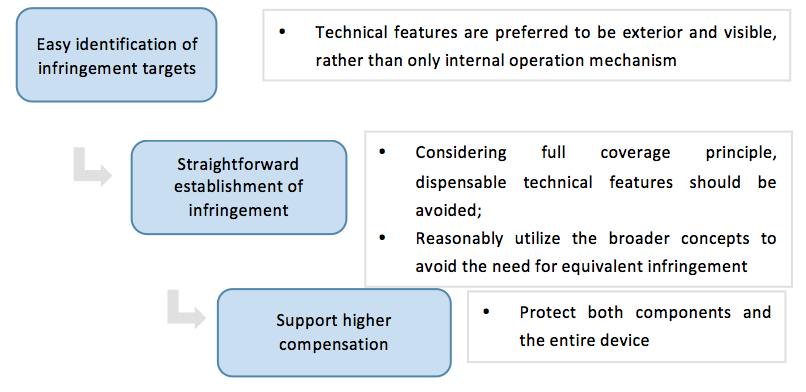
3.1.6 Drafting of Specification
- Patent Eligibility Requirements
In order to present that AI-related inventions are eligible, the specification of an AI related invention should be drafted as being able to constitute a technical solution, that is, the three elements of technical problem, technical means and technical effect should be substantially reflected in the specification.
It is quite common that an AI related invention aims to perform a specific task by using computational models and/or algorithms, which, however, are regarded as rules and methods for mental activities under the Chinese Patent Law. Therefore, in order to get a patent right in China, it is necessary for an AI related invention to serve a technical purpose to solve a technical problem. That is, the technical field or technical application scenario for using the AI should be recorded in the specification.
According to the current Examination Guidelines, statement of technical problem is required to be included in the specification, but in practice, lacking of statement is not a defect that needs to be corrected. That is to say, a technical problem solved by an invention does not necessarily need to be explicitly recorded in the specification. So basically an applicant may decide by him or herself whether or not to include a clear statement of technical problem in the specification.
Generally speaking, we do not recommend to specifically state a technical problem in the specification because it will limit the invention to resolve the stated specific technical problem. In practice, it is usually not allowable for the patentee to argue for another technical problem which is not recorded in the specification when enforcing the patent right in an infringement lawsuit or defending the patent right in an invalidation procedure initiated by others. However, if an AI related invention does not clearly have a “technical” purpose, it is highly recommended to record in the specification a technical problem or specify technical inefficiency of the prior art in the background part of the specification, and/or record in the specification a technical effect in the embodiment part of the specification, so as to convince the examiner that the invention is for solving problems comprising a technical problem.
A significant change made to the Examination Guidelines in April 1, 2017 is that a claim relating to a business model is no longer excluded from patentability. Before the change, business method related invention was very likely to be rejected as being rules and methods for mental activities for which no patent right shall be granted. So, before the revision of the Examination Guidelines, in order to give the examiner a “good” first impression that the invention is not purely business method, it was very important to state clearly a technical problem in the specification for a business method related invention. Currently thanks to the revision, such statement of technical problem is not so important than before, but still, a clear statement of technical problem is helpful for a business method related invention or an AI related invention which could be regarded as “non-technical” purpose.
- Sufficient Disclosure Requiremen
According to Article 26, clause 3 of the Patent Law of China, “The specification shall set forth the invention or utility model in a manner sufficiently clear and complete so as to enable a person skilled in the relevant field of technology to carry it out; where necessary, drawings are required.”
According to the current Examination Guidelines, for an invention application relating computer programs, the principle flow chart of the computer program should be presented in the drawings, and explanation of every step of the computer program should be made in the specification in natural language based on the flow chart in chronological order. The main technical features of the computer program shall be described in the specification to such an extent that a person skilled in the art can, on the basis of the flow chart presented in the specification and explanation thereof, produce the computer program capable of producing the technical effect as described in the specification. Source code is not required to be provided in the specification, which, however, may be partly presented by using marked program language that is customarily used to help understanding of the invention, when necessary.
An invention utilizing AI usually comprises non-technical features, such as algorithm which is regarded as rules and methods for mental activities. If both technical features and non-technical features are involved in an invention utilizing AI, the non-technical features must be those features that are associated with the technical features and function in common with the technical features. In this case, the current Guidelines for Patent Examination, Part II, Chapter 9, Section 6.3.1 clearly stipulates that "the specification should state how the technical features and the algorithm features or business rules and methods that functionally support each other and interact with each other work together and produce beneficial effects. For example, when algorithm features are included, abstract algorithms should be combined with specific technical fields, and the definitions of at least one input parameter and its related output results should be associated with specific data in the technical field.; when business rule and method features are included, the entire process of solving technical problems should be described and explained in detail, so that those skilled in the art can implement the solution of the invention according to the content recorded in the specification." In other words, it should be described clearly and completely how the abstract rules and methods for mental activities, e.g., algorithm, are combined with the specific application scenario and how the parameters are defined and associated with all kinds of data in such application scenario, so that a person skilled in the art is able to follow the contents in the specification and drawings to carry out the invention utilizing the AI, and therefore to solve the technical problem declared to be resolved by the invention and to produce the expected results.
For example, if an AI algorithm (or a prediction model, or a learning model) is built based on training data to output a particular result in accordance with inputted data, the algorithm itself should be described clearly, what data set is used as the inputting data and how the data are processed to obtain predicted output data should be disclosed in the specification to enable a person skilled in the art to carry out the invention by using the same or similar data set. If different data sets are used for training the learning algorithm, the differences between the data sets and how the differences are used in training the learning algorithm should be described clearly in the specification. It is dangerous to just describe a “black box algorithm,” or to just mention “a neural network” unless using of such algorithm or neural network is commonly known as prior art.
Case Example of Insufficient Disclosure:
The patent holder, Shanghai Zhizhen, holds a Chinese patent ZL200410053749.9 regarding a chatting robot system (called “Little i Robot”). Shanghai Zhizhen believed Apple’s Siri function has the same function with its patent technology and then initiated a patent infringement lawsuit by taking Apple as the defendant before Shanghai Intermediate Court in June 2012. As a countermeasure, Apple initiated the patent invalidation procedure against Zhizhen’s patent at the Patent Reexamination Board (PRB) with insufficient disclosure as one of the reasons for invalidating the patent. This case is regarded as the first AI invention infringement and invalidation case in China. The patent right was decided as valid by the PRB. Apple then initiated patent administrative lawsuit by taking the PRB as the defendant before the Beijing Intellectual Property Court, but the PRB’s decision was sustained by the Beijing Intellectual Property Court. Apple then appealed the case to the Beijing High People’s court.
In April 2015, the Beijing High People’s Court ruled that the patent does not sufficiently disclose the mechanism of chatting robot so that persons in the art cannot obtain the technical effect of how user interacts with the chatting robot to play games (which is regarded as the distinguishing feature of the invention over the prior art). In particular, the description does not clearly describe how to analyze the input format sentence and/or natural language and then send the content related to game to the game server.
In June 2020, the Supreme People's Court revoked the judgment of the Beijing Higher People's Court and upheld the judgment of the Beijing Intellectual Property Court and the decision of the Patent Reexamination Board, that is, the patent right was finally maintained in effect. The Supreme People's Court determined that the technical features of the game server belonged to the technical features shared with the existing technology, rather than distinguishing technical features, and therefore had lower requirements for full disclosure. Those skilled in the art can know all the existing technologies in this field and have the ability to apply conventional experimental methods, and can search the existing technologies by themselves to realize the functions of shared technical features. There is no need for the specification to give specific guidelines. Therefore, in this case, those skilled in the art can know how to implement the technical features of the game server based on their knowledge level, so that the technical features are fully disclosed.
From the above case between Apple and Shanghai Zhizhen, although the Supreme People’s Court finally determined that the patent was sufficiently disclosed, it can be learned that sufficient disclosure of invention is crucial for an invention, especially for the technical part relating to the inventive idea of the invention. Once the “insufficient disclosure” issue is raised by the examiner during the substantive examination stage for an invention application, or by a patent right challenger during a corresponding invalidation procedure, it will be very difficult for the applicant/patentee to argue for this issue. One dilemma is, if you argue that the undisclosed technical part to be a part of the prior art, it may result in non-obviousness issue of the invention, but if you argue that the undisclosed technical part to be uniquely proposed in in the invention, it does not cure the defect of insufficient disclosure at all.
- Support for the Claims Requirement
According to Article 26, clause 4 of the Patent Law of China, “The claims shall be supported by the description and shall define the extent of the patent protection sought for in a clear and concise manner.”
In order to obtain relatively broader protection scope, it is commonly seen that a technical solution defined by a claim, especially an independent claim, is the summarization of the embodiments disclosed in the specification. Such summarization, however, is often objected to by the examiner in an office action on the grounds that the protection scope of the claim is not supported by the specification. In such circumstances, the applicant’s arguments are difficult to be accepted by the examiner if no sufficient number of embodiments are recorded in the specification. Therefore, it is important for the specification to have multiple embodiments to support a generic protection scope of a claim.
For an AI related invention utilizing algorithms or mathematical models, sometimes it is hard to limit the invention to a certain technical field because it will significantly narrow the invention to this specific technical field. In such case, it is recommended to describe multiple application scenarios for using the AI. It is possible that the multiple application scenarios may lead to the unity problem, but the unity problem may be easily resolved by filing divisional applications.
3.1.7 Conclusion
Any patentable invention must be a technical solution in China, and an AI related invention does not have any exemption in this regard. Since an AI related invention often involves the using of algorithms and/or computational models, it is highly recommended to describe the technical field or application scenario of using the AI in the specification and in the claims. Under the current Examination Guidelines, an AI related invention will not be excluded for patentability only if non-technical features are involved. However, it is highly recommended to describe the close inter-connection between the technical features and non-technical features in the specification and in the claims so as to make both the technical features and non-technical features function in common to resolve a technical problem.
Considering the fact that Chinese enterprises are very active in developing, researching and utilizing AI technologies and AI technologies are highly encouraged by Chinese governments in all levels, it is expectable that inventions utilizing AI will be relatively easy to get protected in China.
3.2 AI-related Patent Practice in the United of States
This section presents recommendations regarding AI-related patent application drafting under the patent laws of the United States. In U.S., for patent applications and grants, AI is defined as comprising one or more of the following eight component technologies: knowledge processing, speech, AI hardware, evolutionary computation, natural language processing, machine learning, vision, and planning control.
3.2.1 Main Provisions Related to Obtaining of Patent Right
Main provisions of the U.S. Patent Law and Manual of Patent Examining Procedure (MPEP) to be considered at the stage of AI-related patent prosecution are shown as in the below table.
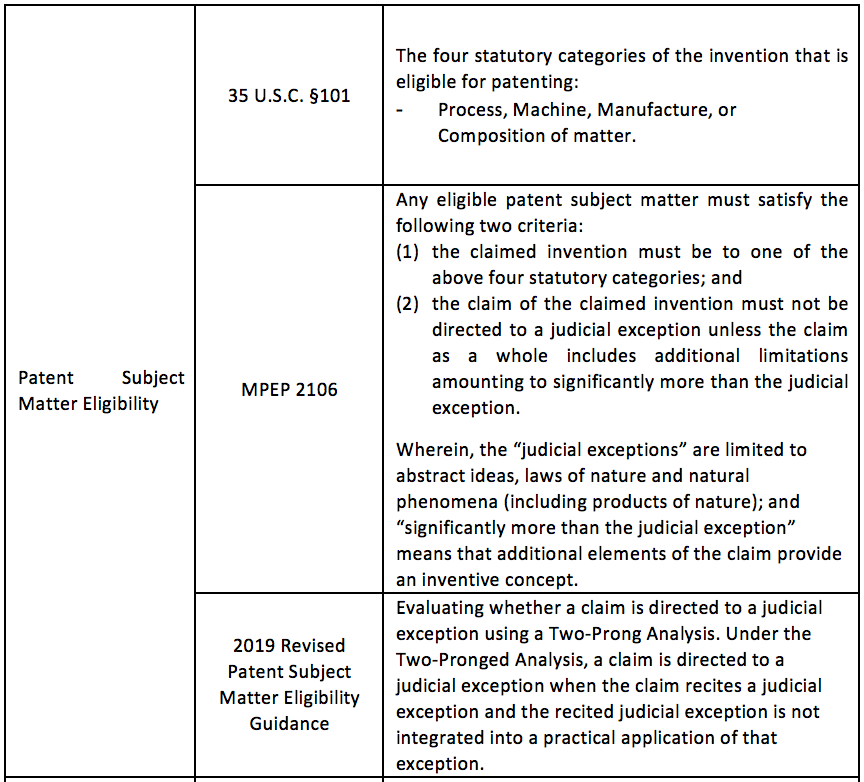
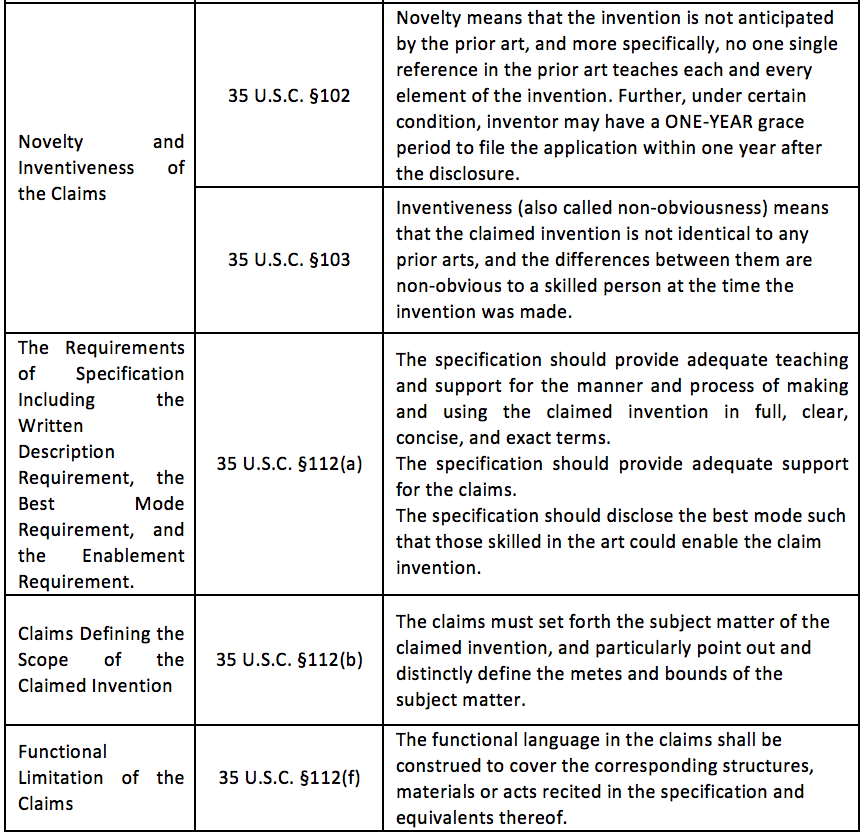
3.2.2 Eligibility of Patent Subject Matter
In this part, 2019 Revised Subject Matter Eligibility Guidance and Examples published by USPTO are introduced.
In the field of AI, strategies for developing patent portfolio in the United States share great similarities with those in China. Essentially, when filing an AI-related patent application, the U.S. and China both require subject matter eligibility, novelty, and inventiveness of the invention. Further, a full, clear, concise, and exact disclosure of the invention is necessary, including claims that clearly define the protection scope sought for. Enablement of the invention is also a common requirement, which ensures that the technical solution involved in the invention can be realizable by those skilled in the art.
However, in practice, the determination of whether the subject matter of an AI-related invention is eligibility in the United States is more complicated. On the basis of the Alice Two-Part Test, formulated from the U.S. Supreme Court (see Alice Corp. v. CLS Bank International, 573 U.S. 208 (2014)), in 2019, the 2019 Revised Patent Subject Matter Eligibility Guidance (2019 PEG) was published in order to increase clarity, predictability and consistency in how 35 U.S.C. §101 is applied during the examination, as well as enable examiners to more readily determine if a claim does recite an abstract idea of the judicial exception.
In the 2019 PEG, the examination procedure to evaluate subject matter eligibility has been revised with respect to Step 2A by introducing a new Two-Prong Analysis. Under this new two-prong analysis, a claim directing to a process, a machine, a manufacture, or a composition of matter can be eligible unless it recites a judicial exception but the exception is not integrated into a practical application. For a claim reciting a judicial exception but the exception is not integrated into a practical application, the claim will be re-evaluated to determine whether additional elements that significantly more than the judicial exception are recited (i.e., determine whether the claim elements are more than well-understood, routine, conventional activity in the relevant field. The 2019 PEG, further limits the “abstract idea” in Prong One to the following three groupings: mathematical concepts, certain methods of organizing human activity, and mental processes. Figure 3.2.2-1 demonstrates the flowchart to evaluate subject matter eligibility under 2019 PEG.
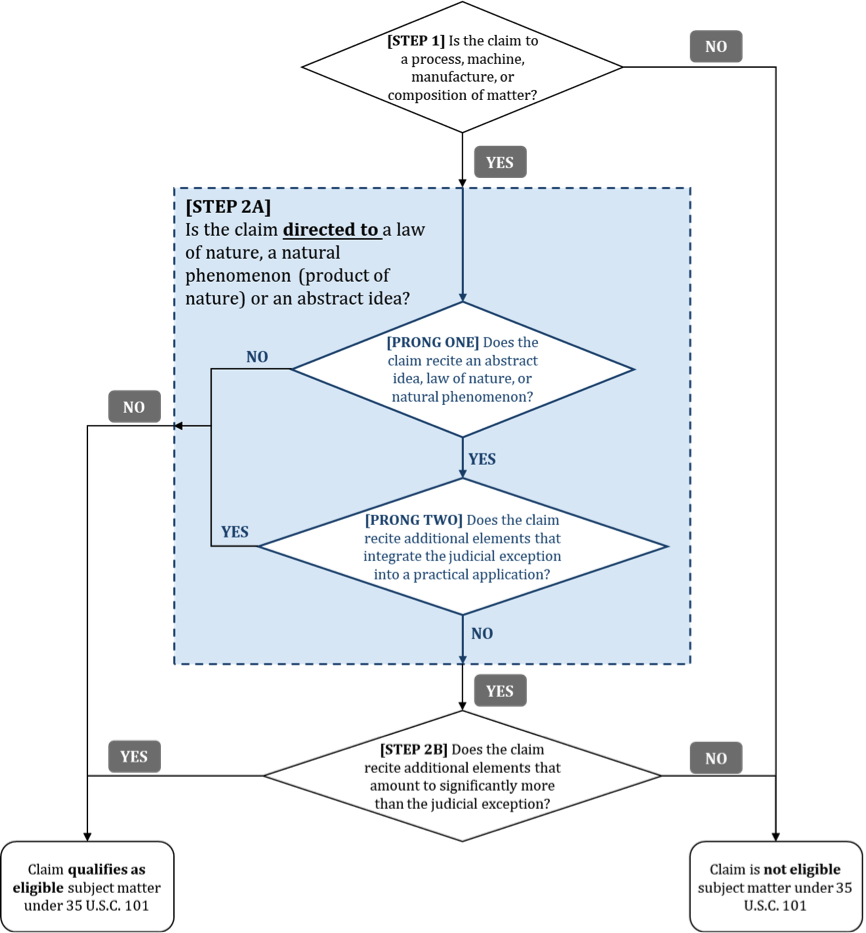
Fig. 3.2.2-1
Further, along with the 2019 EPG, the USPTO has issued numerous examples (see Subject Matter Eligibility Examples: Abstract Ideas) to illustrate how to apply the 2019 EPG to practice, for example, to computer-related inventions, and software.
One of these examples (“Example 39”) demonstrates a situation in which the claim does not recite any of the judicial exceptions enumerated in the 2019 PEG. In particular, Example 39 relates to an AI-related hypothetic invention and claims a computer-implemented method of training a neural network for facial detection as follows:
“A computer-implemented method of training a neural network for facial detection, comprising:
collecting a set of digital facial images from a database;
applying one or more transformations to each digital facial image including mirroring, rotating, smoothing, or contrast reduction to create a modified set of digital facial images;
creating a first training set comprising the collected set of digital facial images, the modified set of digital facial images, and a set of digital non-facial images;
training the neural network in a first stage using the first training set;
creating a second training set for a second stage of training comprising the first training set and digital non-facial images that are incorrectly detected as facial images after the first stage of training; and
training the neural network in a second stage using the second training set.”
According to the USPTO’s analysis, though some of the claim elements may be based on mathematical concepts (e.g., the one or more transformations are mathematical transformation functions), the mathematical concepts are not recited in the claims. Further, the claimed steps are not practically performed in the human mind, then the claim does not direct to a mental process. The claim also does not recite any method of organizing human activity such as a fundamental economic concept or managing interactions between people. Therefore, the USPTO states that the above claim is patent-eligible because the claim does not fall into any of the three groupings of the abstract idea.
Another AI-related hypothetic invention directs to a method for adaptive monitoring of network traffic data (“Example 40”). In this example, the USPTO provides two sets of claims as follows:
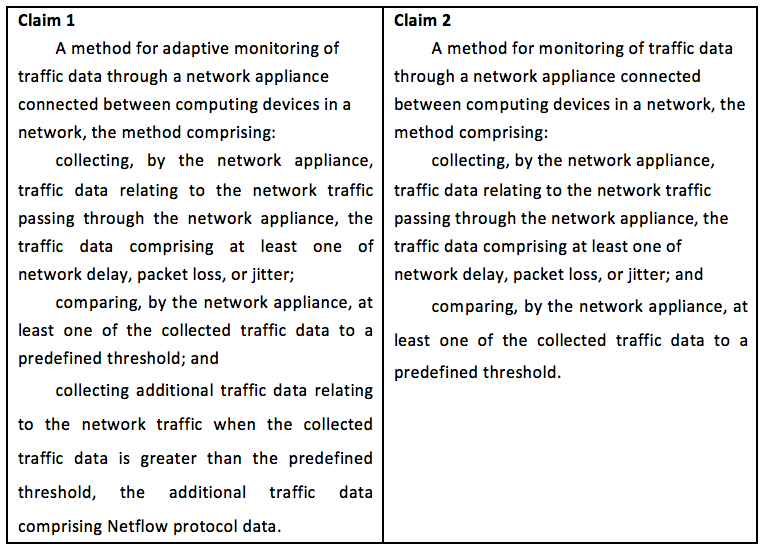
From the above, it can be noticed that the main difference between Claim 1 and Claim 2 is that Claim 1 further includes one more feature that “collecting additional traffic data relating to the network traffic when the collected traffic data is greater than the predefined threshold, the additional traffic data comprising Netflow protocol data.” However, such a difference renders Claim 1 eligible while Claim 2 ineligible.
Referring to the USPTO’s analysis, Claim 1 and Claim 2 both belongs to a mental process. This is because both of the two claims recite the feature of “comparing, by the network appliance, at least one of the collected traffic data to a predefined threshold”, however, the mere language of “by the network appliance” cannot precludes the step from practically being performed in the mind. In other words, a nominal recitation of a generic network appliance does not remove the claim from the mental processes grouping.
Though Claim 1 and Claim 2 are determined having recited judicial exception after applying Prong One of Step 2A, only Claim 1 as a whole integrates the judicial exception into a practical application. Specifically, the above-mentioned one more feature recited in Claim 1 avoids excess traffic volume on the network and hindrance of network performance, and provides a specific improvement over prior systems, and results in an improved network monitoring. Therefore, Claim 1 is eligible. In comparison, additional elements (features other than the one directed to the mental process) in Claim 2, are no more than mere instructions to apply the mental process using a generic computer component (i.e., the network appliance), which means no meaningful limits have been imposed on practicing the abstract idea. In this case, the abstract idea is not integrated into a practical application in view of Prong Two of Step 2A, and the claim as a whole is an abstract idea.
Furthermore, according to Figure 3.5.2-1, Claim 2 should be further evaluated in Step 2B. USPTO has included the following statements in its analysis, that “[u]nder the 2019 PEG, a conclusion that an additional element is insignificant extra-solution activity in Step 2A should be re-evaluated in Step 2B … to determine if it is more than what is well-understood, routine, conventional activity in the field.” In this example, mere collection of data in a merely generic manner (i.e., by the network appliance) is a well-understood, routine, conventional activity and does not provide any inventive concept. Thus, Claim 2 is not eligible.
In another example (“Example 41”), the USPTO provides a hypothetic invention relates to a method for establishing cryptographic communications between two computer terminals.
The example claim recites a mathematical concept by claiming that “encoding each of the message block word signals MA to produce a ciphertext word signal CA, whereby CA=MAe (mod n)”. The mathematical concept is integrated into a process that secures private network communications in view of the combination of additional elements in the claim (i.e., (“receiving the plaintext word signal at the first computer terminal”, “transforming the plaintext word signal to one or more message block word signals MA”, and “transmitting the encoded ciphertext word signal CA to the second computer terminal over a communication channel”). So, the example claim is eligible.
In this example, USPTO has also states that the abstract idea can be integrated into a practical application by a well-understood, routine, conventional activity, and this should not be evaluated in Prong Two of Step 2A.
In yet another example (“Example 42”), the claimed invention is a method of managing interactions between people which allows for users to access patients’ medical records and receive updated patient information in real time from other users. In this example, two claims are provided and both of the two claims recite the method of organizing human activity. However, one of the two claims, Claim 1, recites an improvement over prior arts by allowing remote users to share information in real time in a standardized format regardless of the format in which the information was input by the user, showing an integration of the abstract idea into a practical application. Therefore, Claim 1 is eligible. On the other hand, Claim 2 just simply implement the abstract idea on a generic computer, which cannot be considered as a practical application of the abstract idea. Claim 2 does not provide any inventive concept that can be added to the abstract idea as well, rendering Claim 2 ineligible.
3.2.3 Regarding Additional Elements
In this part, USPTO Guidance to adress wether aditional eements represent well-understood, routine, conventional activity are introduced.
As mentioned above, determining whether additional elements that significantly more than the judicial exception are recited is to determine whether the claim elements are more than well-understood, routine, conventional activity in the relevant field. USPTO release a memorandum on April 19, 2018 to clarify the determination of whether an additional element represents well-understood, routine, conventional activity. The memorandum was released in view of the Federal Circuit decision in Berkheimer case (see Berkheimer v. HP Inc., 881F.3d 1360 (Fed. Cir. 2018)).
In Berkheimer, the invention of the disputed U.S. Patent No. 7,447,713 (‘713 patent) relates to digitally processing and archiving files in a digital asset management system. The independent claim 1 of the ‘713 patent recites:
1. A method of archiving an item in a computer processing system comprising:
presenting the item to a parser;
parsing the item into a plurality of multi-part object structures wherein portions of the structures have searchable information tags associated therewith;
evaluating the object structures in accordance with object structures previously stored in an archive;
presenting an evaluated object structure for manual reconciliation at least where there is a predetermined variance between the object and at least one of a predetermined standard and a user defined rule.
In addition, the specification of the ‘713 patent describes an inventive feature that stores parsed data in a purportedly unconventional manner. In detail, the specification mentions that the conventional digital asset management systems include numerous documents containing multiple redundant document elements, which lead to inefficiencies and increased costs. However, the claimed invention can increase efficiency and computer functionality over the prior art systems, as recited in the specification (see the ‘713 patent at 16:52-60):
“By eliminating redundancy in the archive 14, system operating efficiency will be improved, storage costs will be reduced and a one-to-many editing process can be implemented wherein a singular linked object, common to many documents or files, can be edited once and have the consequence of the editing process propagate through all of the linked documents and files. The one-to-many editing capability substantially reduces effort needed to up-date files which represent packages or packaging manuals or the like as would be understood by those of skill in the art.”
In the decision, the Federal Circuit concludes that the above claim 1 is directed to the abstract idea of parsing and comparing data, however, it does not recite any of the purportedly unconventional activities disclosed in the specification. In particular, the Federal Circuit opined that “Claim 1 recites a method of archiving including parsing data, analyzing and comparing the data to previously stored data, and presenting the data for reconciliation when there is a variance. It does not include limitations which incorporate eliminating redundancy of stored object structures or effecting a one-to-many change of linked documents within an archive.” Thus, the elements of claim 1 amount to no more than performing the abstract idea of parsing and comparing data with conventional computer components, without including the purportedly unconventional manner. In this case, the Federal Circuit holds that claim 1 is ineligible under step 2B of the eligibility determination.
3.2.4 Regarding Computer-Implemented Functional Claim
In this part, examination of computer-implemented functional claim limitations for compliance with 35 U.S.C. §112 is introduced.
During the practice, USPTO found that functional language is likely to be used to claim computer-implemented inventions, such as most of the AI-related inventions. To a better understanding on how to draft a computer-implemented functional claims having functional limitations, and on how to meet requirements of written description and enablement, a guidance has been released by USPTO in 2019.
In general, a patent application should have proper written description and enablement support in the disclosure of the application. Further, for the computer-implemented functional claims, functional limitations (i.e., claim limitations that define an element in terms of the function it performs without reciting the structure, materials, or acts that perform the function) are required to be properly treated as means (or step) plus function limitation and to be sufficiently definite.
In particular, for a computer-implemented functional claim performs a specific computer function, the specification must disclose an algorithm for performing the claimed specific computer function. Further the specification must be consulted to determine the corresponding structure, material, or act for performing the claimed function, wherein the corresponding structure should be a computer specially programmed to perform the disclosed algorithm. A failure of disclosing any algorithm or the disclosed algorithm is not sufficient to perform the entire claimed function(s) will result in the indefiniteness of the computer-implemented claim.
The following is an example where the written description is insufficient to support computer-implemented claim limitations. On the basis of Media Rights Techs., Inc. v. Capital One Financial Corp., 800 F.3d 1366, 1374 (Fed. Cir. 2015), USPTO provides a hypothetical claim derived from the disputed patent, US 7,316,033, as follows:
“A method of preventing unauthorized recording of electronic media comprising:
activating a compliance mechanism in response to receiving media content by a client system, the compliance mechanism coupled to the client system, the client system having a media content presentation application operable thereon and coupled to the compliance mechanism;
controlling a data output pathway of the client system by diverting a commonly used data pathway of the media content presentation application to a controlled data pathway;
monitoring the controlled data pathway with the compliance mechanism to ensure there is no unauthorized recording of the media content; and
directing the media content to a custom media device coupled to the compliance mechanism via the data output pathway, for selectively restricting output of the media content.”
In the above claim, the Federal Circuit first determined that the term “compliance mechanism” is a means-plus-function limitation that performs computer-implemented functions including “monitoring the controlled data pathway with the compliance mechanism to ensure there is no unauthorized recording of the media content.” The Federal Circuit then found that the specification does not disclose sufficient structure for the monitoring function. In view of the following portion of the specification,
“… While the newly retrieved portion is presented, CCM 300 then again checks that the rules are enforced, and retrieves an additional portion of the media file or suspends presentation of the media file if the rules are not being enforced, and these steps are performed repeatedly throughout the playback of the media file, in a loop environment, until the media file's contents have been presented in their entirety. Advantageously, by constant monitoring during playing of media files, CCM 300 can detect undesired activities and enforces those rules as defined by CCM 300.”
the Federal Circuit holds that though the specification states that there are set of rules which the compliance mechanism applies to monitor the data pathway, the specification does not provide details about the rules themselves or how the compliance mechanism determine whether the rules are being enforced. Therefore, the “compliance mechanism” limitation of claim 1 is indefinite.
Furthermore, when a claim containing a computer-implemented claim limitation is found to be indefinite as above mentioned, the specification would also lack written description. In this case, the enablement requirement may not be met as well.
3.2.5 Inventorship of AI
Since more inventions are developed in advantage of AI, what if AI starts inventing the invention by itself? Will USPTO accept a patent application wherein the inventor is an AI? The answer is NO.
USPTO has expressed its attitude on the inventor-ship of AI in a recently released decision (see Decision on Petition, Appl. No. 16/524,350 (April 27, 2020)). In this decision, USPTO holds that “AI cannot be an inventor” by interpreting the language used in the U.S. Patent law and MPEP, as well as illustrating with some Federal Circuit decisions. For example, the Federal Circuit stated that “only natural persons can be ‘inventors.’” in an earlier decision (see Beech Aircraft Corp. v. EDO Corp. 755 F. Supp. 985, 987).
Similarly, the CNIPA does not recognize AI as an inventor as well. Referring to Chinese Guidelines for patent examination, in Chapter 1 Section 4.1.2, it has clearly stated that “the inventor shall be the person.”
3.2.6 Case Study
[Case Example 1]
The present case relates to the technology for facial detection in the filed of image processing. On the basis of the application involved in this case, the assume claim is as follows:
“A method for facial spatial positioning, the method comprising:
obtaining a facial image acquired by a single image acquisition device;
performing facial area detection on the facial image to determine position information of a facial area in the facial image; and
determining spatial position information of a face according to the position of the facial area.”
During the examination, the above claim was rejected by the examiner under 35 U.S.C. §101. In particular, the examiner stated that, first, the above claim is directed to a process and falls within the “mental process” grouping of abstract ideas. In other words, the claim recites a judicial exception. The examiner then stated that the claim does not have any additional element that integrates the judicial exception into a practical application. The examiner also stated that the claim does not include additional elements that are sufficient to amount to significantly more than the judicial exception.
To overcome the above examiner’s opinion raised during the examination, amending the claim as follows:
“A method for facial spatial positioning, the method comprising:
obtaining a facial image acquired by a single image acquisition device;
performing facial area detection on the facial image to determine position information of a facial area in the facial image; and
determining spatial position information of a face according to the position of the facial area and predetermined position information of a facial rectangle box within which the single image acquisition device performs facial recognition.”
In view of the 2019 PEG, the following argument has been made along with the amended claim. In the argument, it has first focus on rebutting examiner’s opinion that “the claim recites a judicial exception”. In the above claim, the recited features “a facial image acquired by a single image acquisition device” and “the single image acquisition device performs facial recognition” can not be performed in the human mind and thus the claim does not relate to a mental process. Even though the claim is regarded as reciting a mental process, a further argument is made that the technical solution sought protection in the amended claim has practical value and can solve specific technical problems, e.g., improving the field of image processing. Moreover, it is also argued that elements in the amended claim are significantly more than a judicial exception, rather than merely describing a well-understood or routine or conventional activity in the field.
Base on the above amended claim and the argument, the application overcome the rejection under 35 U.S.C. §101.
[Case Example 2]
This case mainly focuses on how to argue that “the claim recites additional elements that amount to significantly more than the judicial exception” in responding the Office Action. The invention in this case relates to a video monitoring method. During the examination, the examiner raised the opinion that the claim directs to a judicial exception without including additional elements that are sufficient to amount to significantly more than the judicial exception, and thus the claim is rejected under 35 U.S.C. §101.
To overcome the rejection, the claim has been amended and an argument has been made in the response to the Office Action. The followings are a comparison chart of the original filed claim and the amended claim, both derived from the actual case, and the argument made in the response.
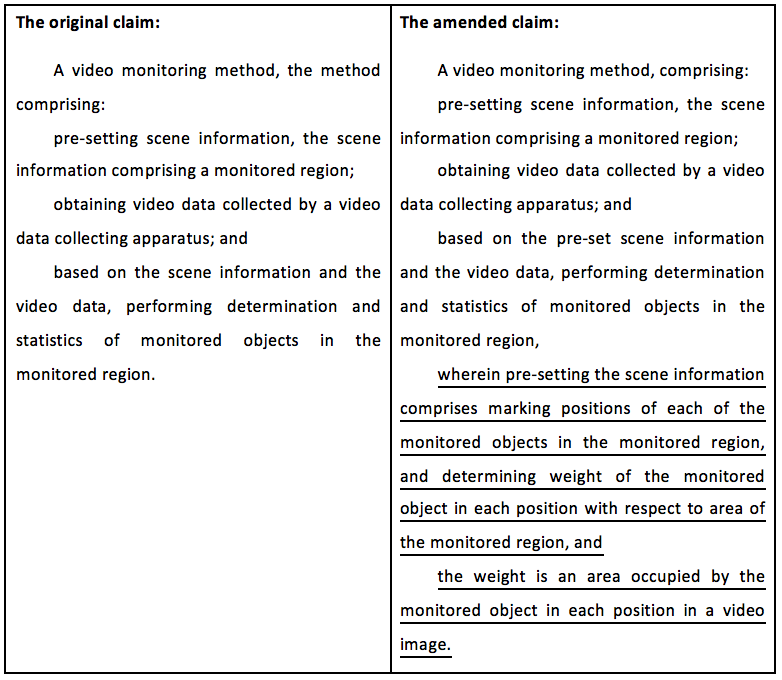
The amended claim recites the features “marking positions of each of the monitored objects in the monitored region,” “determining weight of the monitored object in each position with respect to area of the monitored region” and “the weight is an area occupied by the monitored object in each position in a video image.” These features are obvious significantly more than an abstract idea that can be implemented by an operator. Therefore, the amended claim complies with 35 U.S.C. §101.
3.3 AI-related Patent Practice in Europe
This section will introduce the patent practice related to artificial intelligence (AI) under the European Patent Law.
……
(To be continued...)



